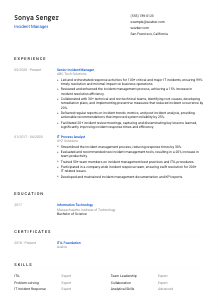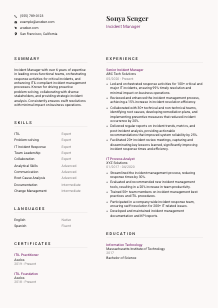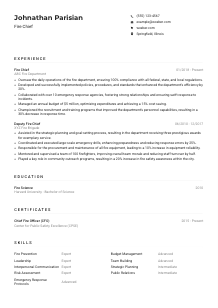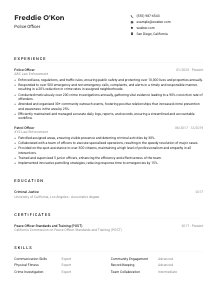Incident Manager Resume Example
Tackling crises, but your resume looks more hazardous than adventurous? Calm the chaos with this Incident Manager resume example, fine-tuned using Wozber free resume builder. Discover how to showcase your composure and decisive action to align with job specifics, setting your career trajectory to be as smooth as can be!

How to write an Incident Manager resume?
Hello, aspiring Incident Manager! In the fast-evolving world of IT and crisis management, standing out in a sea of candidates is no small feat. Your resume isn't just a document; it's a powerful tool to exhibit your expertise, dedication, and readiness to take on critical incidents. Guided by Wozber's free resume builder, this in-depth guide will navigate you through the intricacies of constructing a resume that's not only a perfect match for your dream role but also optimized for Applicant Tracking Systems (ATS).
So, are you ready to elevate your resume game? Let's delve into sculpting a compelling narrative that catapults you into the Incident Manager role you're eyeing!
Personal Details
The Personal Details section is your resume's opening act. It might seem straightforward, but it's your first opportunity to make an impression. Below, we'll uncover how to tailor this section for the Incident Manager position, ensuring it resonates well with recruiters and aligns with job expectations.
1. Name as Your Brand
Think of your name as the headline of your professional story. Opt for a clean, bold font to make it immediately eye-catching. This small detail sets the stage for the rest of your resume by establishing a strong presence.
2. Job Title Alignment
Directly beneath your name, reflect the job title you're pursuing. For this exercise, "Incident Manager" clearly states your career objective and aligns with the recruiter's expectations, making your intentions unmistakable.
3. Essential Contact Information
In this digital age, a mobile number and a professional email address (firstname.lastname@example.com) are non-negotiable. These are your direct lines of communication, so accuracy and professionalism are key. Also, by leveraging Wozber, you can ensure your details are laid out in an ATS-friendly resume format, negating any parsing issues.
4. Location Relevance
Specifying "San Francisco, California" caters directly to the job's geographic requirements, assuring the hiring manager of your availability without the need for relocation complications. Highlighting this proactively can edge you closer to an interview.
5. Professional Links
If you have a LinkedIn profile or a professional website, include it. Make sure they complement the narrative of your resume, presenting a cohesive and comprehensive professional image. This could be your secret sauce in conveying your broader expertise and professional network.
Takeaway
The Personal Details section is your gateway to making a stellar first impression. It's more than just basic information; it subtly communicates your professionalism, attention to detail, and alignment with the job's logistics. Let each detail count and set the tone for the narrative that unfolds.





Experience
In the realm of Incident Management, your experience speaks volumes. This is your canvas to demonstrate how you've navigated the turbulent waters of IT crises. Let's sculpt your Experience section to display the depth of your expertise in managing and mitigating incidents.
- Led and orchestrated response activities for 100+ critical and major IT incidents, ensuring 99% timely resolution and minimal impact on business operations.
- Reviewed and enhanced the incident management process, achieving a 15% increase in incident resolution efficiency.
- Collaborated with 30+ technical and non‑technical teams, identifying root causes, developing remediation plans, and implementing preventive measures that reduced incident occurrence by 20%.
- Delivered regular reports on incident trends, metrics, and post‑incident analysis, providing actionable recommendations that improved system reliability by 25%.
- Facilitated 20+ incident review meetings, capturing and disseminating key lessons learned, significantly improving incident response times and efficiency.
- Streamlined the incident management process, reducing response times by 30%.
- Evaluated and recommended new incident management tools, resulting in a 20% increase in team productivity.
- Trained 50+ team members on incident management best practices and ITIL procedures.
- Participated in a company‑wide incident response team, ensuring swift resolution for 200+ IT‑related issues.
- Developed and maintained incident management documentation and KPI reports.
1. Dissecting the Job Description
Begin by breaking down the job description, noting keywords and phrases such as "lead and coordinate response activities" or "collaborate with technical and non-technical teams." This step is critical for ATS optimization, ensuring you speak the same language as the system and the hiring manager.
2. Chronological Layout
Structure your experience in reverse chronological order, starting with the most recent. This layout not only aligns with ATS-friendly resume formats but also allows the recruiter to see your growth trajectory and recent achievements upfront.
3. Achievement-focused Statements
For each role, craft bullet points that reflect your successes and responsibilities, mirroring the job's needs. For example, "Led and orchestrated response activities for 100+ critical incidents, ensuring 99% timely resolution." This quantifies your impact and demonstrates relevance.
4. Quantify Wherever Possible
Quantifying achievements lends them credibility and scale. Whether it's highlighting the percentage improvement in incident resolution efficiency or the number of cross-functional teams led, numbers provide tangible proof of your capabilities.
5. Relevancy is Key
With limited space, prioritizing experiences that resonate with the Incident Manager role is vital. This focused approach not only makes for a more compelling read but also ensures you're showcasing your most transferable skills and achievements.
Takeaway
Your experience is the cornerstone of your resume, a testament to your ability to navigate and resolve high-stakes incidents. By tailoring your experience to match the job requirements and employing strategic ATS optimization through Wozber, you're not just listing your past roles; you're presenting a narrative of growth, impact, and relevancy.
Education
The foundation of any solid Incident Manager resume lies in its education section. While seemingly straightforward, it's an opportunity to further align with the job's requirements. Below, we will sculpt this section to underline your suitability for the role, based on your academic background.
1. Identifying Educational Requirements
Highlight the education prerequisites from the job description - in this case, a "Bachelor's degree in Information Technology, Computer Science, or a related field." Matching these criteria with your academic credentials is your first step toward satisfying the job's educational demands.
2. Clear and Concise Structure
Adopt a straightforward format listing your degree, field of study, the institution's name, and your graduation year. An ATS-friendly resume format, as facilitated by Wozber, ensures this information is easily navigable for both the human eye and ATS.
3. Highlighting Your Degree
It's crucial your degree title precisely matches those listed in the job description if you hold them. This direct match can significantly enhance your resume's ATS optimization, making it clear you meet the educational criteria outlined.
4. Relevant Courses and Achievements
If applicable, showcasing pertinent coursework, honors, or extracurricular involvements can add depth to your profile. Though more significant for early-career professionals, any specialized training that directly pertains to Incident Management is worth mentioning.
5. Continuous Learning
The tech field is ever-evolving, and so should your education section. Whether it's completing new certifications or attending relevant workshops, ongoing education illustrates your commitment to staying at the forefront of IT Incident Management.
Takeaway
Your educational background is not just a criterion to be met; it's a reflection of your foundational knowledge and your dedication to your professional development. Through strategic presentation and emphasizing continued learning, your education section will bolster your candidacy for the Incident Manager role.
Certificates
In the world of Incident Management, certifications are not just accolades; they are a testament to your dedication and expertise. Below, let's dissect how to frame your certifications to shine brightly on your resume, illustrating your qualifications in a field that prizes continuous improvement.
1. Align With Job Requirements
Zero in on certifications the job posting highlights, like "ITIL Foundation" or "ITIL Practitioner." Listing these credentials directly responds to the job's call for in-depth ITIL knowledge, significantly enhancing your ATS optimization by echoing key phrases.
2. Quality Over Quantity
Prioritize listing certifications that are most relevant to the role over an exhaustive compilation. This focused approach ensures your most pertinent qualifications catch the recruiter's eye without being drowned out by less relevant achievements.
3. Dates Matter
Particularly for certifications with expiration dates or those recently achieved, including the acquisition or validity period demonstrates your current competency and commitment to professional development.
4. Stay Ahead of the Curve
The tech world is dynamic, with new standards and practices constantly emerging. Regularly updating your certification list and pursuing new learning opportunities showcase your dedication to staying abreast of industry advancements.
Takeaway
Your certifications are a potent section of your resume, directly reflecting your expertise and readiness for the Incident Manager role. By carefully selecting and presenting these credentials, you underscore your commitment to excellence and lifelong learning, making you a compelling candidate.
Skills
The Skills section of your resume is your chance to highlight the tools you bring to the Incident Manager role. It's about precision - showcasing not just what you can do, but how what you can do is exactly what the position requires. Let's refine this section to reflect your suitability unmistakably.
1. Decipher the Job Description
Analyze the job posting for explicit and implied skills. Phrases like "strong analytical and problem-solving skills" and "demonstrated ability to lead" are your clues. Matching these in your skill set plays into the hands of ATS optimization by mirroring the language seen in the job posting.
2. Skill Alignment is Crucial
Highlight the most relevant hard and soft skills from the job description. For an Incident Manager, this might include ITIL expertise, analytical thinking, and team leadership. This direct correlation demonstrates to hiring managers that you're not just a fit; you're the right fit.
3. Organized and Honest
Resist the temptation to list every skill you possess. An organized, focused list is far more effective at catching a recruiter's eye. Also, honesty about your proficiency levels builds trust and sets a realistic expectation of your capabilities.
Takeaway
Your skills tell a story of your professional journey and readiness for the Incident Manager role. Deliberately selected and presented, they can make your resume irresistible to recruiters. Remember, every skill you list is a promise of value, so choose wisely and back them up with real-world achievements.
Languages
In our globalized world, language skills can catapult you into new realms of opportunity. For Incident Managers, especially those in diverse and international environments, linguistic capabilities can be a significant asset. Learn how to succinctly present your language skills to align with potential job requirements.
1. Job Requirement Analysis
Check the job posting for any specific language requirements or preferences. For instance, "Must be highly proficient in English" immediately sets a primary criterion for your linguistic section.
2. Prioritize Accordingly
List English first to align with the job's stated requirement, adding a level of proficiency to illustrate your capability clearly. This direct response to the job's criteria showcases your attentiveness to detail and readiness to meet the role's demands.
3. Showcasing Additional Languages
Even if additional languages are not stipulated in the job description, listing them can highlight your cultural versatility and potential to engage in diverse work environments. This could set you apart in a crowded field of applicants.
4. Honesty in Proficiency
When indicating proficiency, be honest and clear. Utilizing terms like "Native," "Fluent," "Intermediate," and "Basic" provides a quick, clear snapshot of your linguistic capabilities, ensuring there's no ambiguity.
5. The Broad View
Consider the bigger picture of the role's demands. For broad-reaching Incident Management roles, multiple language skills signify an ability to navigate global incidents and communicate across cultural boundaries, enhancing your profile's attractiveness.
Takeaway
Languages are not just tools for communication; they are bridges to understanding diverse cultures and contexts. Highlighting your linguistic skills, particularly those explicitly required by the job, can significantly enhance your resume's appeal. Embrace your multilingual talents as assets that enrich your professional persona.
Summary
The Summary section is your moment to shine, to encapsulate your professional identity in a few powerful sentences. For an Incident Manager, this is where you weave your expertise, skills, and unique value into a compelling narrative. Let's craft a summary that captivates and convinces.
1. Grasping the Job's Essence
Deeply understand the job requirements, noting key phrases and skills. This foundational knowledge will guide you in highlighting how your expertise aligns with the position, setting the stage for an impactful summary.
2. Crafting a Powerful Introduction
Start with a statement that encapsulates your professional identity: "Incident Manager with over 6 years of expertise..." Immediately, this tells your audience who you are and the depth of your experience.
3. Reflecting Key Requirements
Integrate skills and achievements that respond to the job posting, such as your ability to lead cross-functional teams or enhance ITIL-compliant processes. This targeted approach shows not just compatibility, but excellence for the role.
4. Brevity and Impact
Condense your professional essence into 3-5 lines that encourage further reading. This teaser should leave no doubt in the recruiter's mind about your suitability and eagerness for the Incident Manager position.
Takeaway
Your summary is the elevator pitch of your professional journey, an encapsulation of your readiness and enthusiasm for the Incident Manager role. By aligning it closely with the job requirements, you're signaling not just your qualifications but your exceptional fit for the position. Make every word count, and let your summary open the door to your next career adventure.
Embarking on Your Incident Manager Odyssey
Congratulations on meticulously crafting each section of your Incident Manager resume! Armed with a compelling narrative, optimized for ATS and resonating with hiring managers, you're set to embark on an exciting career journey. Remember, your resume is a dynamic document, a reflection of your growing expertise and achievements. Use Wozber's free resume builder, including free ATS-friendly resume templates and ATS resume scanner, to keep your resume in top shape, ensuring you navigate the competitive landscape with confidence.
The path to your dream Incident Manager role is now clearer. Embrace the journey, refine your skills, and let your resume be the beacon that guides you to your next professional milestone. Here's to crafting your success story!

- Bachelor's degree in Information Technology, Computer Science, or a related field.
- Minimum of 5 years of experience in IT incident management or related roles.
- In-depth knowledge of ITIL practices and certifications such as ITIL Foundation or ITIL Practitioner.
- Strong analytical, problem-solving, and communication skills.
- Demonstrated ability to lead and manage cross-functional teams during high-priority incidents.
- Must be highly proficient in English.
- Must be located in San Francisco, California.
- Lead and coordinate response activities for all critical and major IT incidents, ensuring timely resolution and minimal impact on business operations.
- Regularly review and update the incident management process and related documentation to ensure that incidents are resolved efficiently and effectively.
- Collaborate with technical and non-technical teams to identify root causes, develop remediation plans, and implement preventive measures.
- Provide regular reports on incident trends, metrics, and post-incident analysis to senior management.
- Facilitate incident review meetings, ensuring that all relevant stakeholders are involved and lessons learned are captured and shared.















